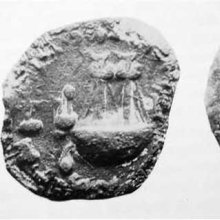Pulumavi, Pulumāvi: 1 definition
Introduction:
Pulumavi means something in the history of ancient India. If you want to know the exact meaning, history, etymology or English translation of this term then check out the descriptions on this page. Add your comment or reference to a book if you want to contribute to this summary article.
Images (photo gallery)
India history and geography
Source: Shodhganga: Ajanta’s antiquityPulumāvi I (r. 0-36 CE) is a king from the Sātavāhana dynasty of ancient India. The Sātavāhana lineage (known as Andhra in the Purāṇas) once ruled much of the Deccan region and several of the Ajantā caves at West-Khandesh (West-Khaṇḍeśa, modern Jalgaon) were carved in the 3rd century BCE when the region was ruled by kings (e.g., Pulumāvi I) and descendants of the Sātavāhana kings. Pulumāvi I was preceded by Śātakarṇi III and succeeded by Gaurakṛṣṇa.
Pulumāvi II reigned 69-71 CE, was preceded by Hala and succeeded by Purindraṣeṇa. Pulumāvi II is also known as Puttalka or Maṇḍalaka.
Pulumāvi III reigned 130-158 CE, was preceded by Gautamiputra Śātakarṇi and succeeded by Śivaśri (Śātakarṇi). Pulumāvi II is also known as Vaśiṣṭhiputra.
Pulumāvi IV reigned 207-217 CE, was preceded by Chandra Śri Śātakarṇi.

The history of India traces the identification of countries, villages, towns and other regions of India, as well as mythology, zoology, royal dynasties, rulers, tribes, local festivities and traditions and regional languages. Ancient India enjoyed religious freedom and encourages the path of Dharma, a concept common to Buddhism, Hinduism, and Jainism.
See also (Relevant definitions)
Full-text: Shivashri, Puttalka, Gautamiputra, Hala, Purindrasena, Mandalaka, Candrashri, Vasishthiputra, Chandrashri, Shatakarni, Dakshinapatha.
Relevant text
Search found 2 books and stories containing Pulumavi, Pulumāvi; (plurals include: Pulumavis, Pulumāvis). You can also click to the full overview containing English textual excerpts. Below are direct links for the most relevant articles:
Maritime Tradition of Andhra < [April – June, 1982]
Amaravati Art in the Context of Andhra Archaeology (by Sreyashi Ray chowdhuri)
The rule of the Sadas < [Chapter 4 - Survival of Amarāvatī in the Context of Andhra Art]
The rule of the Sātavāhanas < [Chapter 4 - Survival of Amarāvatī in the Context of Andhra Art]
Lower Kṛṣṇā Valley (8): Nāgārjunakoṇḍa < [Chapter 2 - Amarāvatī and other Archaeological Sites of Ancient Andhra Pradesh]
